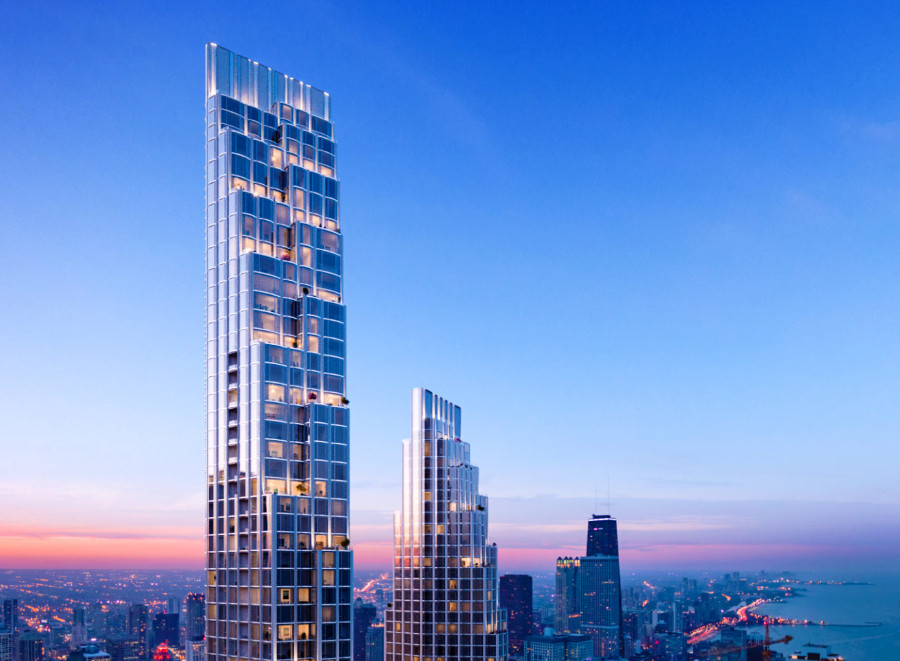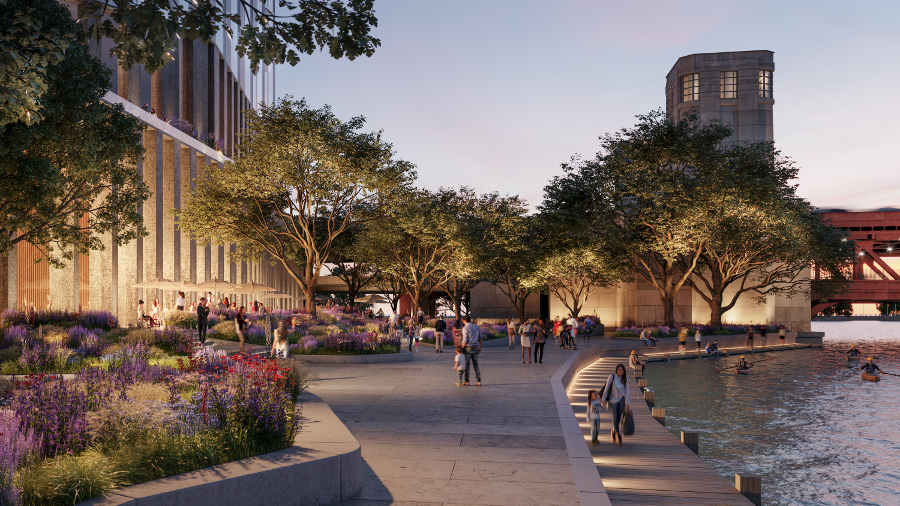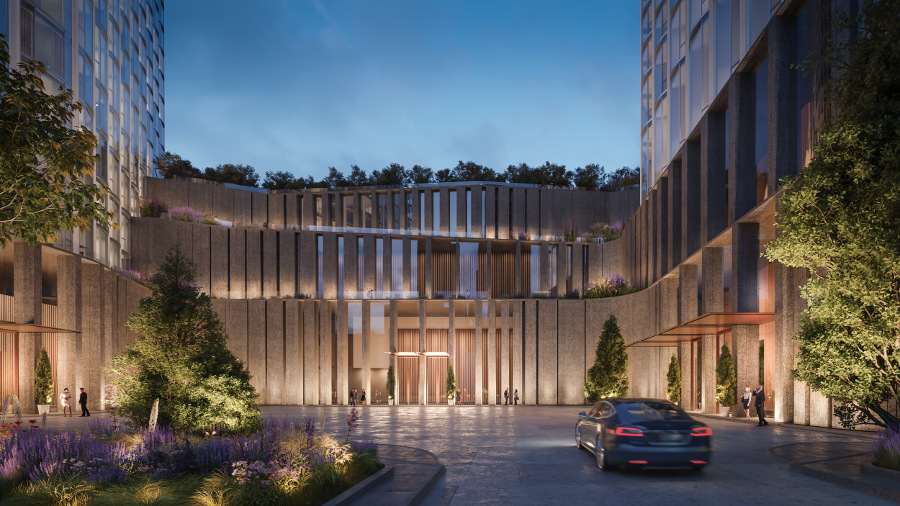Up until a few days ago, the main meeting room at Skidmore, Owings & Merrill’s Chicago office was secured with a padlock and its glass window walls covered up with paper. This was done to prevent prying eyes from getting a glimpse into the team’s latest project, says Michael Pfeffer, a former SOM architect who was poached two years ago by mega-developer Related Midwest to help oversee big undertakings in Chicago. After years of planning, SOM and Related Midwest finally took the wraps off of their latest proposal this week, unveiling a pair of dramatic towers for 400 N. Lake Shore Drive, or as most Chicagoans know it, the site of the failed Chicago Spire skyscraper (more background on the failed supertall tower here).
The big public reveal comes nearly four years after Related took control of the coveted Streeterville property from the Chicago Spire’s developers. Originally imagined as a 2,000-foot-tall spiraling skyscraper in the center of the Chicago skyline, the ambitious Spire was never realized, and instead, all that was completed was a gigantic foundation hole in the ground. The Spire hole has been around for so long—since the project stalled out in 2008—that it’s almost become a legend in itself. More than simply a hole in the ground, the remains of the Spire project is a very real physical connection to and stark reminder of the real estate boom and bust from the last decade.
Unfinished business
The saga of the Spire is an important story in the lore of Chicago architecture, one that remained in the minds of Related staff from the very beginning. “We knew going into this that it’s not just a high-profile, desirable location, but one that all Chicagoans feel vested in,” says Ann Thompson, Senior Vice President of Architecture and Design with Related Midwest, speaking to the prominent position in the Chicago skyline that 400 Lake Shore Drive will fill. Fully aware of the history of the site and the spectacular failure that was the Spire, Thompson says that coming to the table with a plan that makes economic sense is crucial to seeing the site finally transformed, and the final chapter of the Spire story concluded.

In terms of programming and numbers for the mega-development, here’s what Related is proposing for 400 Lake Shore Drive: a 1,100-foot-tall south tower which will house 300 upscale for-sale condos and 175-room hotel rooms as well as a 850-foot-tall north tower with 550 market-rate rental apartments. The development will also feature 750 vehicle parking spaces over four below-grade level. The Spire’s foundation hole won’t be repurposed for the new two-tower project, but an expensive retaining wall that was a part of the Spire’s foundation work will help in laying the groundwork for the new development.
Filling the Spire hole won’t be the only unfinished business that the new proposal will settle. In addition to the two-tower project, Related is also committing $10 million to see the completion of DuSable Park, a three-acre parcel of land on the other side of Lake Shore Drive which has sat fallow even longer than the Spire site. Highly contaminated after years of industrial use, the piece of infill has been subject to a lengthy remediation by the Chicago Park District with funding from the EPA. But before DuSable Park is delivered, the space will be used as a staging area for construction equipment and materials to build the mega-project at 400 Lake Shore Drive.
Sibling towers
Since acquiring the site, Related has been under pressure to come forth with a truly special proposal for it. Enter David Childs, a career architect with SOM whose credits include significant supertall structures in New York City, including One World Trade Center and the under-construction 35 Hudson Yards. Childs, whose design language is well-rooted in New York, was tapped to produce not only a future icon for Chicago, but one that looks and feels like it belongs in Chicago. Bill Baker, a structural engineer whose breadth of knowledge and expertise in the field helped to bring seemingly-impossible towers such as the Burj Khalifa in Dubai to life, is in charge of translating the design team’s vision into a feasible form that will work for the challenging site.

The team has produced a pair of contemporary towers that nod to Chicago’s past while also speaking to a present (and potentially future) design language. From afar, viewers will see sibling towers, staggered in height, with sweeping setbacks that continue from the base to the top. But upon closer inspection, passersby will discover details that are reminiscent of Chicago’s earliest high-rise buildings. Most notably, the towers will be clad in terracotta and feature bay windows similar in layout and size to those found in early Chicago School skyscrapers. But that’s not all—SOM architect Scott Duncan says that the tower’s aesthetic also harkens to the bundled tube design of the Willis Tower, with floors tapering off as the buildings grow in height. And in a way, Childs adds, the pair will be siblings, very much in a way that SOM’s Hancock Center and Willis Tower are.
What the towers are not are dark, brooding behemoths like Willis or Hancock, or even the original World Trade Center twins. Instead, Childs says that 400 Lake Shore Drive is more elegant not only in appearance, but in the way it speaks to its neighbors. Breaking up the development into two separate towers not only slims down the project’s massing, but it also allows space in between the pair to create a sort of a “gateway” to the Chicago River, Childs adds. The architect compares the Chicago skyline–specifically the buildings along the Chicago River–to a piece of music, describing the new design for 400 Lake Shore Drive as “two notes at the end of the symphony.”

While the towers won’t break any records for height, Childs notes that the the pair of glass and terracotta buildings are still very tall. As proposed, the 850-foot-tall north tower will stand at approximately the same height as Related’s One Bennett Park being completed nearby, while the south tower will rise to a height which officially qualifies the tower as a “supertall” skyscraper while also earning it a place in the list of tallest buildings in Chicago. And with a central location in the skyline and along both the Chicago River and lakefront, the completed residences are likely to offer some of the very best views that money can buy.
Fears of another bubble
Chicagoans have waited years for a new proposal for the failed Spire site, and could wait another four and a half years until this new project is completed, Related’s timeline indicates. While a decade has passed since the Spire stalled out, the trauma of the recession is still very fresh in the minds of many, and despite concerns of overbuilding, the pace of new Chicago tower proposals and mega-developments has seemed to hit fever pitch. Related Midwest alone is juggling a handful of major projects around the city, including the redevelopment of a sprawling 62-acre riverfront site in the South Loop.

Thompson acknowledges growing fears of another real estate bubble, but says that Related’s size, partnerships, and experience in completing challenging projects should provide some assure to the public that the firm will do what it takes to get the job done. While 400 Lake Shore Drive is still wildly ambitious, Thompson says that it’s a much more pragmatic and feasible project compared to something like the Chicago Spire. The site’s desirable location on the river and lakefront is also a sort of built-in assurance that the project will remain competitive in a growing pack of high-profile downtown tower projects, Thompson adds.
Then there’s also ongoing negotiations with Alderman Brendan Reilly and residents of his downtown ward. During the open question and comment period during this week’s community presentation in Streeterville, a number of concerns were brought up by residents, particularly issues with vehicle congestion, decaying infrastructure around the site, and public safety along the riverwalk—all items which Alderman Reilly suggested that he was willing use as bargaining chips with Related. However, once all compromises are made, construction crews could break ground by this time next year, Related Midwest president Curt Bailey indicated during the public meeting.
Related Midwest is truly putting its reputation and legacy on the line with this project. It’s a tremendous risk, but one that could also deliver a tremendous reward—not only reward the developer and its partners, but also for Chicago architecture lore. “We’re ready to get back to work,” Childs said at the end of a meeting at SOM’s Chicago office on Wednesday morning. The tower would not only be another prominent feather in the architect’s cap, but one that could become the centerpiece of the Chicago skyline.



